
Mexican cuisine consists of the cooking cuisines and traditions of the modern country of Mexico. Its earliest roots lie in Mesoamerican cuisine. Its ingredients and methods begin with the first agricultural communities such as the Olmec and Maya who domesticated maize, created the standard process of nixtamalization, and established their foodways. Successive waves of other Mesoamerican groups brought with them their cooking methods. These included: the Teotihuacanos, Toltec, Huastec, Zapotec, Mixtec, Otomi, Purépecha, Totonac, Mazatec, Mazahua, and Nahua. With the Mexica formation of the multi-ethnic Triple Alliance, culinary foodways became infused.

A taco is a traditional Mexican dish consisting of a small hand-sized corn- or wheat-based tortilla topped with a filling. The tortilla is then folded around the filling and eaten by hand. A taco can be made with a variety of fillings, including beef, pork, chicken, seafood, beans, vegetables, and cheese, and garnished with various condiments, such as salsa, guacamole, or sour cream, and vegetables, such as lettuce, onion, tomatoes, and chiles. Tacos are a common form of antojitos, or Mexican street food, which have spread around the world.

Tex-Mex cuisine is a regional American cuisine that originates from the culinary creations of Tejano people. It has spread from border states such as Texas and others in the Southwestern United States to the rest of the country. It is a subtype of Southwestern cuisine found in the American Southwest.

A fajita, in Tex-Mex cuisine, is any stripped grilled meat, optionally served with stripped peppers and onions usually served on a flour or corn tortilla. The term originally referred to skirt steak, the cut of beef first used in the dish. Popular alternatives to skirt steak include chicken and other cuts of beef, as well as vegetables instead of meat. In restaurants, the meat is usually cooked with onions and bell peppers. Popular condiments include shredded lettuce, sour cream, guacamole, salsa, pico de gallo, shredded cheese, refried beans, and diced tomatoes. "Tacos de arrachera" is applied to the northern Mexican variant of the dish.

The cuisine of California reflects the diverse culture of California and is influenced largely by European American, Hispanic American, East Asian and Oceanian influences, and Western European influences, as well as the food trends and traditions of larger American cuisine.

Offal, also called variety meats, pluck or organ meats, is the internal organs of a butchered animal. The word does not refer to a particular list of edible organs, and these lists of organs vary with culture and region, but usually exclude skeletal muscle. Offal may also refer to the by-products of milled grains, such as corn or wheat.

The cuisine of the Southwestern United States is food styled after the rustic cooking of the Southwestern United States. It comprises a fusion of recipes for things that might have been eaten by Spanish colonial settlers, cowboys, Native Americans, and Mexicans throughout the post-Columbian era; there is, however, a great diversity in this kind of cuisine throughout the Southwestern states.

Recado rojo or achiote paste is a popular blend of spices. It is now strongly associated with Mexican and Belizean cuisines, especially of Yucatán and Oaxaca. The spice mixture usually includes annatto, oregano, cumin, clove, cinnamon, black pepper, allspice, garlic, and salt. The annatto seeds dye the mixture red, and impart a distinctive red-orange color to the food.
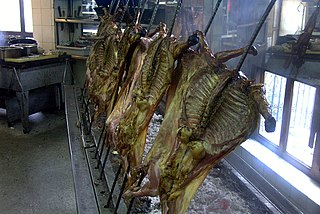
Cabrito is the name in both Spanish and Portuguese for roast goat kid in various Iberian and Latin American cuisines.

New Mexican cuisine is the cuisine of the Southwestern US state of New Mexico. The region is primarily known for its fusion of Pueblo Native American cuisine with Hispano Spanish and Mexican cuisine originating in Nuevo México. This Southwestern culinary style is popular beyond the current boundaries of New Mexico, and is found throughout the old territories of Nuevo México and the New Mexico Territory, today the state of Arizona, parts of Texas, and the southern portions of Colorado, Utah, and Nevada.
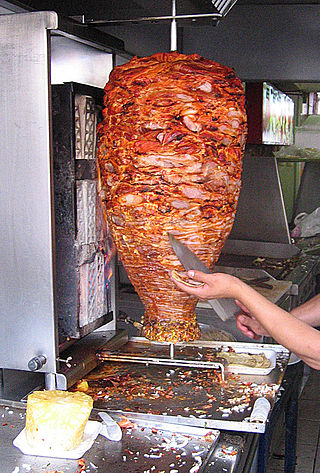
Al pastor, tacos al pastor, or tacos de trompo is a preparation of spit-grilled slices of pork originating in the Central Mexican region of Puebla and Mexico City, although today it is a common menu item found in taquerías throughout Mexico but most prominently is from these two parts of the country, where it is largely found. The method of preparing and cooking al pastor is based on the lamb doner brought by Lebanese immigrants to the region. Al pastor features a flavor palate that uses traditional Mexican adobada (marinade). It is a popular street food that has spread to the United States. In some places of northern Mexico and coastal Mexico, such as in Baja California, taco al pastor is known as taco de trompo or taco de adobada.

Beef brains and veal or calf's brains are used in the cuisines of France; Italy; Spain; El Salvador; Mexico, etc. where they are called sesos in Spanish and are eaten in tacos and quesadillas; Pakistan and Bangladesh also in parts of India like Kolkata and Kerala, where they are known in Urdu and Bengali as Maghaz; Portugal; Egypt, where they are eaten fried and Indonesia.

Mexican street food, called antojitos, is prepared by street vendors and at small traditional markets in Mexico. Street foods include tacos, tamales, gorditas, quesadillas, empalmes, tostadas, chalupa, elote, tlayudas, cemita, pambazo, empanada, nachos, chilaquiles, fajita tortas, even hamburgers and hot dogs, as well as fresh fruits, vegetables, beverages and soups such as menudo, pozole and pancita. Most are available in the morning and the evening, as mid-afternoon is the time for the main formal meal of the day. Mexico has one of the most extensive street food cultures in Latin America, and Forbes named Mexico City as one of the foremost cities in the world in which to eat on the street.

A burrito in Mexico is, historically, a regional name, among others, for what is known as a taco, a tortilla filled with food, in other parts of the country. The term burrito was regional, specifically from Guanajuato, Guerrero, Michoacán, San Luis Potosí and Sinaloa, for what is known as a taco in Mexico City and surrounding areas, and codzito in Yucatán and Quintana Roo. Due to the cultural influence of Mexico City, the term taco became the default, and the meaning of terms like burrito and codzito were forgotten, leading many people to create new meanings and folk histories. In modern times, it is considered by many as a different dish in Mexican and Tex-Mex cuisine that took form in Ciudad Juárez, consisting of a flour tortilla wrapped into a sealed cylindrical shape around various ingredients. In Central and Southern Mexico, burritos are still considered tacos, and are known as “tacos de harina”. The tortilla is sometimes lightly grilled or steamed to soften it, make it more pliable, and allow it to adhere to itself. Burritos are often eaten by hand, as their tight wrapping keeps the ingredients together. Burritos can also be served "wet", i.e., covered in a savory and spicy sauce, when they would be eaten with a fork and knife.
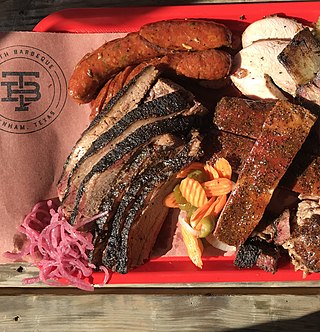
Texan cuisine is the food associated with the Southern U.S. state of Texas, including its native Southwestern cuisine influenced Tex-Mex foods. Texas is a large state, and its cuisine has been influenced by a wide range of cultures, including Tejano/Mexican, Native American, Creole/Cajun, African-American, German, Czech, Southern and other European American groups. The cuisine of neighboring states also influences Texan cuisine, such as New Mexican cuisine and Louisiana Creole cuisine. This can be seen in the widespread usage of New Mexico chiles, Cayenne peppers, and Tabasco sauce in Texan cooking.

Cuerito is pig skin from Mexican cuisine, Venezuelan cuisine and Spanish cuisine. Cuero is the Spanish-language word for skin, leather or hide, so cueritos means "little skins". They are usually pickled in vinegar and can be made with a spicy sauce. The vinegar can be seasoned with pineapple, dulce macho (piloncillo), cloves, peppercorns, chile de árbol and oregano. There are also family recipes.
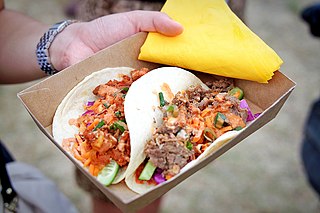
Korean–Mexican fusion is a type of fusion cuisine originally from Los Angeles that combines traditional elements of American-style Mexican and Korean foods. The earliest Korean-Mexican fusion featured Mexican or Tex-Mex dishes such as tacos or burritos filled with Korean-style barbecued meats and kimchi. Typical dishes include Korean tacos and bulgogi burritos. Food critics Jane and Michael Stern state that Korean–Mexican fusion is a growing food trend that has steadily gained in popularity since 2009.

A taco stand or taquería is a food stall, food cart or restaurant that specializes in tacos and other Mexican dishes. The food is typically prepared quickly and tends to be inexpensive. Many various ingredients may be used, and various taco styles may be served. Taco stands are an integral part of Mexican street food. Tacos became a part of traditional Mexican cuisine in the early 20th century, beginning in Mexico City, as what had been a miner's snack began to be sold on street corners in the city. Shops selling tacos have since proliferated throughout Mexico and other areas with a heavy Mexican culinary and cultural influence, including much of the Western United States and most other larger American cities. More typical taquerías specialize in tacos, as expected, but in some localities it can be used to refer to restaurants specializing in burritos, where tacos themselves are less of a point of emphasis.
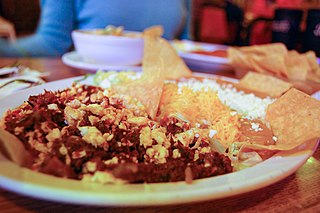
Carne seca is a type of dried beef used in Mexican cuisine.































